
What structure is represented by letter C?
(A) Chloroplast
(B) Cytoplasm
(C) Mitochondria
(D) Golgi body
Answer: D. Golgi Body
Structure C represents the Golgi body, a set of flattened membrane discs that package and sort proteins.
Which of the following is true about natural selection?
(A) It acts on individual organisms, helping them become better adapted to their environment.
(B) It always favors large, strong individuals.
(C) It can only act on traits that are heritable and show variation.
(D) It allows species to choose what adaptations are passed on to offspring.
Answer: C. For natural selection to act on a trait, there must already be variation for that trait. In addition, the trait must be heritable, or able to be passed from parent to offspring
In what part of the digestive tract does most nutrient absorption occur?
(A) Mouth
(B) Stomach
(C) Small intestine
(D) Large intestine
Answer: C. Small intestine
Most nutrients are absorbed through the walls of the small intestine into the circulatory system.
Which of the following would be least harmful to an endangered species?
(A) Introducing a competitor species into the local habitat
(B) Harvesting local natural resources
(C) Releasing excess carbon dioxide into the atmosphere
(D) Reducing the human population
Answer: D. Reducing the human population
The growing human population displaces native species and affects biodiversity.
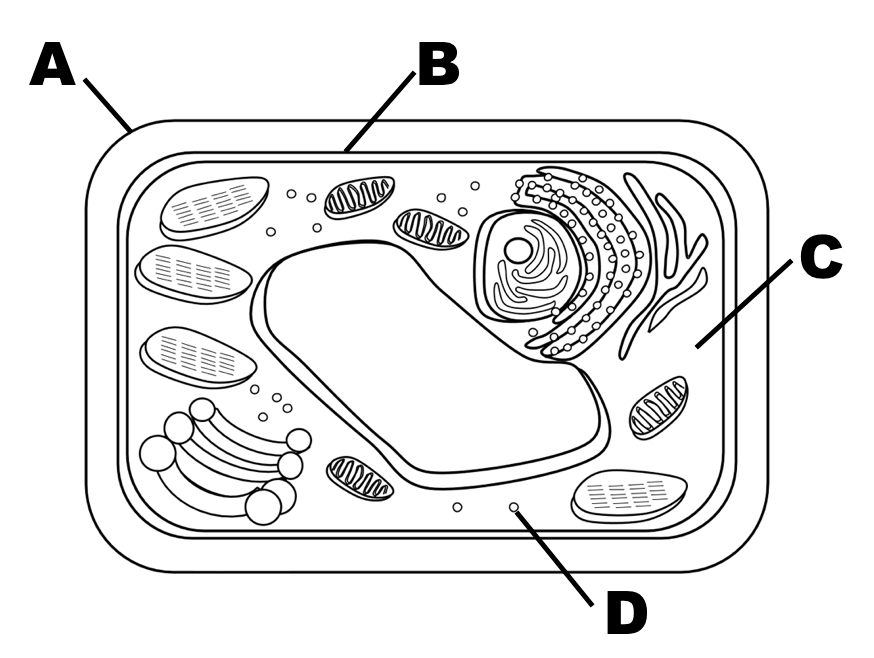
Which structure is represented by letter B?
(A) Cytoplasm
(B) Cell membrane
(C) Cell wall
(D) Ribosome
Answer: B. Cell membrane
Structure B is the cell membrane, which controls what enters and exits the cell.
A student is viewing a cell under a microscope. She determines that it has a nucleus, a cell membrane, a cell wall, and chloroplasts.
(A) Animal cell
(B) Fungal cell
(C) Bacteria
(D) Plant cell
Answer: D. Plant cell
Because of the presence of chloroplasts and a cell wall, the student is looking at a plant cell.
Evolutionary success is often described as “survival of the fittest,” which can be misleading. Which statement better explains the concept of evolutionary success?
(A) Individuals in a reduced gene pool can withstand environmental changes and will survive more frequently than other individuals.
(B) Individuals that develop advantageous physical traits will outcompete others for resources, and pass these traits to their offspring.
(C) Individuals that inherit advantageous variations will outcompete others for resources and pass these variations to the next generation.
(D) Individuals that acquire advantageous traits over their lifetime will survive better and pass those traits on to their offspring.
Answer: C. Individual organisms that have traits that allow them to outcompete others for resources are more likely to survive and reproduce, creating more offspring with the same advantageous traits.
Which of the following is a primary function of the musculoskeletal system?
(A) To transmit electrical signals
(B) To filter blood and maintain electrolyte balance
(C) To transport nutrients throughout the body
(D) To support and move the body
Answer: D. To support and move body
The muscular and skeletal systems work together to support the weight of the body and allow for its movement.
A food chain is represented below.
Phytoplankton ⟶ Krill ⟶ Mackerel ⟶ Sea gull
Which organism in the food chain is a producer?
(A) Phytoplankton
(B) Mackerel
(C) Sea gull
(D) Krill
Answer: A. Phytoplankton
The phytoplankton is a producer, beginning the energy flow of the food chain.
How would the circulatory and respiratory systems be affected by asthma?
(A) The respiratory system would be over-delivering oxygen to the lungs because the person would be breathing too rapidly.
(B) The circulatory system would have a significantly reduced supply of oxygen in the blood, causing oxygen delivery to cells to be reduced.
(C) The circulatory system would have a significantly reduced supply of oxygen in the blood, causing oxygen delivery to cells to increase.
(D) The respiratory system would have difficulty delivering enough oxygen to the lungs because the airways are not wide enough.
There's 2 Answers: B AND D
(B) Since the airways are narrow, the respiratory system isn't bringing in enough air (and oxygen), which means that during the pulmonary circuit, not enough oxygen will enter the blood through the alveoli in the lungs.
(D) Since asthma causes the airways to narrow, not enough air (and oxygen) will flow through the system into the the lungs.
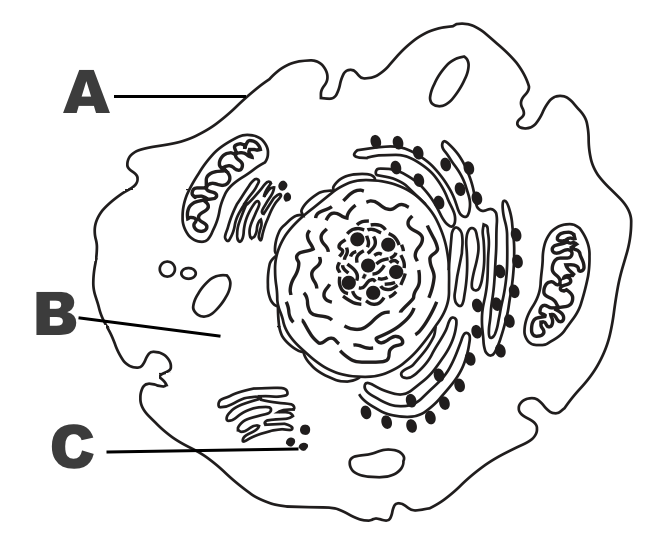
Which structure is represented by letter C?
(A) Cell membrane
(B) Cytosol
(C) Ribosome
(D) Cell Wall
Answer: C. Ribosome
Structure C is a ribosome, which is responsible for protein synthesis.
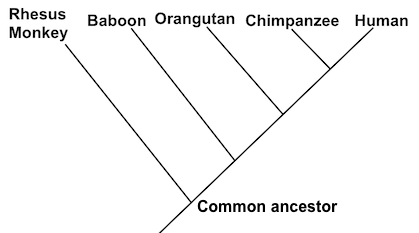
Based on the phylogenetic tree above, which two organisms are least closely related?
(A) Chimpanzee and Rhesus monkey
(B) Baboon and human
(C) Human and Rhesus monkey
(D) Chimpanzee and human
Answer: C. Human and Rhesus monkey
The most recent common ancestor shared between the human and the Rhesus monkey is the unnamed common ancestor at the base of the tree.
Which of the following are parts of the human nervous system?
(A) Hormones and glands
(B) Lungs and trachea
(C) Brain and spinal cord
(D) Esophagus and stomach
Answer: C. The brain and spinal cord make up the central nervous system.
An important species of the Chesapeake Bay community is the Virginia oyster.
The larvae of these oysters settle on top of mature oysters, forming large oyster reefs. Oyster reefs allow small fishes to avoid predators and provide shelter for a variety of marine invertebrates.
Which of the following best describes the role of Virginia oysters in the Chesapeake Bay?
(A) A dominant species
(B) A foundation species
(C) An invasive species
(D) A pioneer species
Answer: B. A foundation species
The Virginia oyster has helped create the environment for other aquatic life to live in.
Two plants growing beside one another try to access limited available sunlight.
(A) Commensalism
(B) Competition
(C) Mutualism
(D) Herbivory
Answer: B. Competition
The two plants are fighting for the same resource - sunlight, making this competition.
What is the smallest unit of life?
(A) Atoms
(B) Viruses
(C) Cells
(D) Molecules
Answers: C. Cells
Cells are the basic units of life. All living things are made of one or more cells.
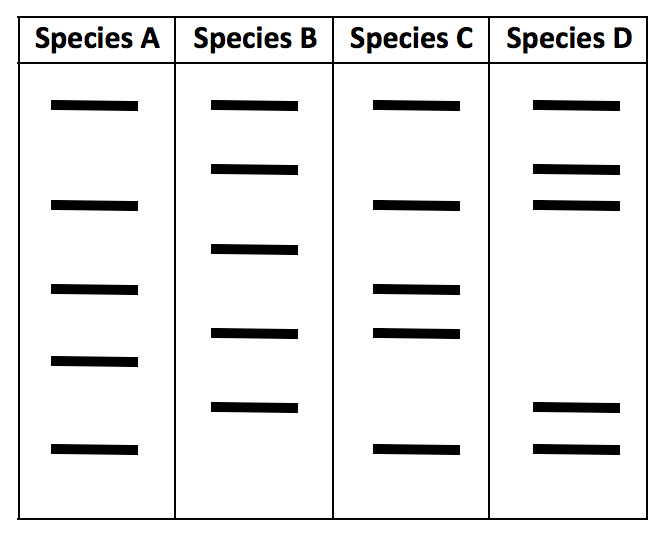
A scientist compares DNA taken from four different living species. Which of the following species is most related to species A?
(A) Species D
(B) Species C
(C) Species B
Answer: B. Species C shares the most number of bands(four bands) with species A
When you swallow, a characteristic "gulp" sound can be heard. This "gulp" is caused by the epiglottis (a flap of tissue) covering the trachea and guiding food/water down the esophagus during swallowing. Which of the following best describes how the epiglottis is connected to the respiratory system's function?
(A) If food/water goes down the trachea, a blockage to the pathway of air in the respiratory system may occur.
(B) Choking on food/water occurs when the epiglottis blocks the pathway of air from the nose to the pharynx.
(C) Choking on food/water occurs when the epiglottis blocks the pathway of air from the bronchi to the bronchioles.
(D) If food/water goes down the esophagus, a blockage to the pathway of air in the respiratory system may occur.
ANSWER: A. If the epiglottis malfunctioned, food/water would travel down the "wrong pipe" (trachea), eventually needing to be coughed up and out of the respiratory tract to prevent the blockage of airflow to the lungs.
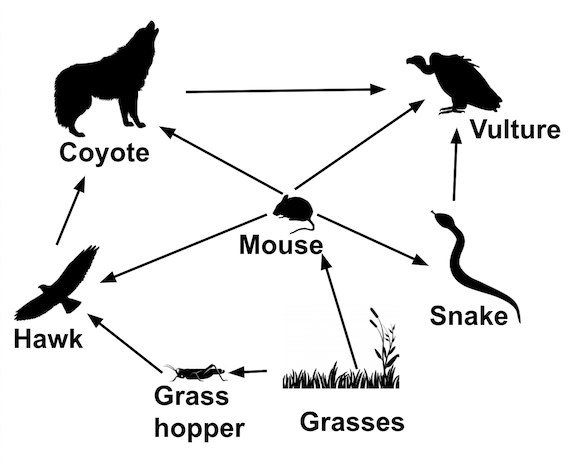
Which of the following is most likely to cause the greatest decrease in the snake population?
(A) A decrease in the hawk population
(B) A decrease in the vulture population
(C) A decrease in the mice population
(D) An increase in the grasshopper population
Answer: C.
Mice are the food source of snakes. If the mice population was drastically reduced, there would be a decrease in the snake's food supply, resulting in the decrease of the snake population.
Which of the following lists the levels of ecology from most specific to least specific?
(A) Population, organism, community, biosphere, ecosystem
(B) Organism, community, population, biosphere, ecosystem
(C) Organism, population, community, ecosystem, biosphere
(D) Community, population, ecosystem, biosphere, organism
Answer: C. Organisms of the same species make up a population. Multiple species make up a community.
The living and nonliving factors in an area make up an ecosystem, and all the ecosystems make up the biosphere.
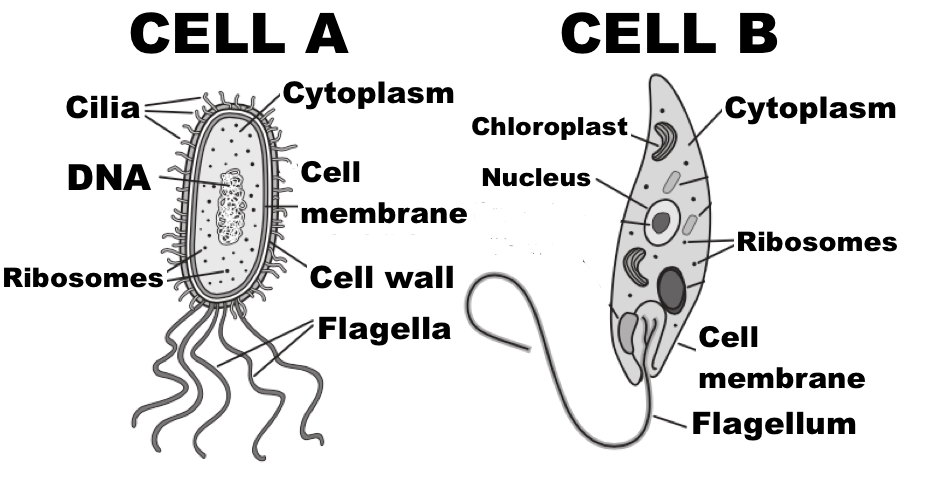
(A) Both Cell A and Cell B are eukaryotic because they have ribosomes.
(B) Cell A is eukaryotic because it has DNA.
(C) Cell B is eukaryotic because it has a nucleus.
(D) Neither Cell A and Cell B are eukaryotic because they have flagella.
Answer: C. Cell B is eukaryotic because it has a nucleus
Cell B has a nucleus and other membrane-bound organelles, which makes it a eukaryote.
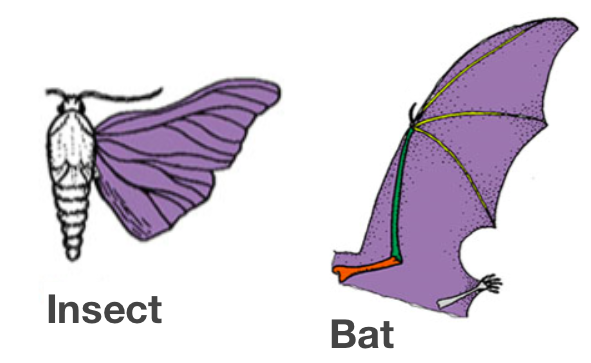
The wings of insects and bats are both used for flying, but have significantly different structures and organizations when compared to one another. What term best describes the relationship between these two wings?
(A) Analogous structures
(B) Vestigial structures
(C) Embryological structures
(D) Homologous structures
Answer: A. Analogous structures
Analogous structures evolved independently in different organisms to have similar functions, such as flying.
Which structure reduces friction between joints?
WHAT IS CARTILAGE
Cartilage is found between joints. It acts as a shock absorber to reduce friction.
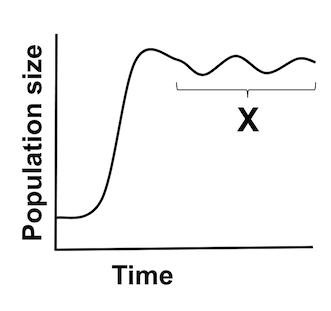
(A) Biodiversity level of the habitat
(B) Carrying capacity
(C) Extinction
(D) The average life span of the species
Answer: B. Carrying capacity
Section X represents the maximum population size that the environment can support.

Based on the phylogenetic tree above, which species are most closely related?
(A) Species II and IV
(B) Species I and II
(C) Species I and IV
(D) Species I and III
Answer: B. Species I and II have the most recent convergence and share the most recent common ancestor.